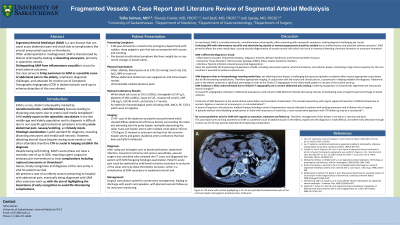Tuesday Poster Session
Category: GI Bleeding
P4206 - Fragmented Vessels: A Case Report and Literature Review of Segmental Arterial Mediolysis
Tuesday, October 29, 2024
10:30 AM - 4:00 PM ET
Location: Exhibit Hall E

Has Audio
- TS
Talha Salman, BSc, MD
University of Saskatchewan
Saskatoon, SK, Canada
Presenting Author(s)
Talha Salman, BSc, MD, Sharyle Fowler, MD, Anil Bedi, MD, Jodi Spelay, MD, FRCSC
University of Saskatchewan, Saskatoon, SK, Canada
Introduction: Segmental Arterial Mediolysis (SAM) is a rare disease that can cause acute abdominal pain and shock due to complications like arterial aneurysmal rupture or thrombosis. Often underreported or misdiagnosed, SAM is characterized by distinct arteriopathy leading to dissecting aneurysms. SAM mainly occurs in the splanchnic vasculature in the elderly population and its diagnosis is difficult due to non-specific GI symptoms including abdominal pain, nausea/vomiting, and bloody stools. Histologic examination is gold standard for diagnosis, revealing dissecting aneurysms and medial wall necrosis. However, obtaining arterial tissue biopsies during acute events is not often attainable therefore CTA is crucial in helping establish Our case serves to bring awareness to SAM as a possible cause of abdominal pain in the elderly, emphasize diagnostic challenges, and advocate for routine use of Computed Tomography Angiography (CTA) in abdominal pain work-ups to enhance detection. We present a case of an elderly woman diagnosed with SAM after thorough evaluation, underscoring the importance of early recognition to prevent life-threatening complications.
Case Description/Methods: A 60-year-old woman presented to the ED with sudden epigastric pain, nausea, and vomiting. Elevated vital signs and abdominal tenderness were noted. Lab tests showed elevated white blood cells, hemoglobin, and lactate. CTA showed a partially thrombosed aneurysm in the hepatic artery. SAM was diagnosed by vascular surgery. Despite no dissecting aneurysms, the pain was attributed to bowel ischemia secondary to SAM. Conservative management was chosen, with aspirin and apixaban prescribed, and planned vascular follow-up with routine CTA monitoring.
Discussion: As mentioned, SAM is a nonatherosclerotic, noninflammatory arteriopathy, often presenting with nonspecific symptoms, making diagnosis challenging yet crucial. Confusing SAM with inflammatory vasculitis and administering steroids or immunosuppressants should be avoided due to ineffectiveness and potential adverse outcomes. Abdominal pain in the elderly comprises a significant percentage of visits to the ED but CTA in the vitally stable patient is not part of the routine work-up. SAM incidence is likely underestimated due to limited CTA use in routine abdominal pain workup, hindering recognition of characteristic segmental and aneurysmal arterial changes. Increased CTA utilization in abdominal evaluations could enhance SAM detection thereby decreasing chances of developing complications.
Disclosures:
Talha Salman, BSc, MD, Sharyle Fowler, MD, Anil Bedi, MD, Jodi Spelay, MD, FRCSC. P4206 - Fragmented Vessels: A Case Report and Literature Review of Segmental Arterial Mediolysis, ACG 2024 Annual Scientific Meeting Abstracts. Philadelphia, PA: American College of Gastroenterology.
University of Saskatchewan, Saskatoon, SK, Canada
Introduction: Segmental Arterial Mediolysis (SAM) is a rare disease that can cause acute abdominal pain and shock due to complications like arterial aneurysmal rupture or thrombosis. Often underreported or misdiagnosed, SAM is characterized by distinct arteriopathy leading to dissecting aneurysms. SAM mainly occurs in the splanchnic vasculature in the elderly population and its diagnosis is difficult due to non-specific GI symptoms including abdominal pain, nausea/vomiting, and bloody stools. Histologic examination is gold standard for diagnosis, revealing dissecting aneurysms and medial wall necrosis. However, obtaining arterial tissue biopsies during acute events is not often attainable therefore CTA is crucial in helping establish Our case serves to bring awareness to SAM as a possible cause of abdominal pain in the elderly, emphasize diagnostic challenges, and advocate for routine use of Computed Tomography Angiography (CTA) in abdominal pain work-ups to enhance detection. We present a case of an elderly woman diagnosed with SAM after thorough evaluation, underscoring the importance of early recognition to prevent life-threatening complications.
Case Description/Methods: A 60-year-old woman presented to the ED with sudden epigastric pain, nausea, and vomiting. Elevated vital signs and abdominal tenderness were noted. Lab tests showed elevated white blood cells, hemoglobin, and lactate. CTA showed a partially thrombosed aneurysm in the hepatic artery. SAM was diagnosed by vascular surgery. Despite no dissecting aneurysms, the pain was attributed to bowel ischemia secondary to SAM. Conservative management was chosen, with aspirin and apixaban prescribed, and planned vascular follow-up with routine CTA monitoring.
Discussion: As mentioned, SAM is a nonatherosclerotic, noninflammatory arteriopathy, often presenting with nonspecific symptoms, making diagnosis challenging yet crucial. Confusing SAM with inflammatory vasculitis and administering steroids or immunosuppressants should be avoided due to ineffectiveness and potential adverse outcomes. Abdominal pain in the elderly comprises a significant percentage of visits to the ED but CTA in the vitally stable patient is not part of the routine work-up. SAM incidence is likely underestimated due to limited CTA use in routine abdominal pain workup, hindering recognition of characteristic segmental and aneurysmal arterial changes. Increased CTA utilization in abdominal evaluations could enhance SAM detection thereby decreasing chances of developing complications.
Disclosures:
Talha Salman indicated no relevant financial relationships.
Sharyle Fowler indicated no relevant financial relationships.
Anil Bedi indicated no relevant financial relationships.
Jodi Spelay indicated no relevant financial relationships.
Talha Salman, BSc, MD, Sharyle Fowler, MD, Anil Bedi, MD, Jodi Spelay, MD, FRCSC. P4206 - Fragmented Vessels: A Case Report and Literature Review of Segmental Arterial Mediolysis, ACG 2024 Annual Scientific Meeting Abstracts. Philadelphia, PA: American College of Gastroenterology.
